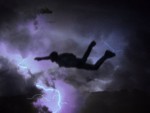 In 1959, Marine Corps pilot William Rankin was cruising at nine miles above the earth in an F-8 Crusader combat jet when something went wrong and he had to eject. Between him and the ground was a big, black storm.
In 1959, Marine Corps pilot William Rankin was cruising at nine miles above the earth in an F-8 Crusader combat jet when something went wrong and he had to eject. Between him and the ground was a big, black storm.
After falling through damp darkness for an interminable time, Rankin began to grow concerned that the automatic switch on his parachute had malfunctioned. He felt certain that he had been descending for several minutes, though he was aware that one’s sense of time is a fickle thing under such distracting circumstances. He fingered the rip cord anxiously, wondering whether to give it a yank. He’d lost all feeling in his left hand, and his other limbs weren’t faring much better. It was then that he felt a sharp and familiar upward tug on his harness–his parachute had deployed. It was too dark to see the chute’s canopy above him, but he tugged on the risers and concluded that it had indeed inflated properly. This was a welcome reprieve from the wet-and-windy free-fall.
Unfortunately for the impaired pilot, he was nowhere near the 10,000 foot altitude he expected. Strong updrafts in the cell had decreased his terminal velocity substantially, and the volatile storm had triggered his barometric parachute switch prematurely. Bill Rankin was still far from the earth, and he was now dangling helplessly in the belly of an oblivious monstrosity.
A cumulonimbus “anvil” cloud.“I’d see lightning,” Rankin would later muse, “Boy, do I remember that lightning. I never exactly heard the thunder; I felt it.” Amidst the electrical spectacle, the storm’s capricious winds pressed Rankin downward until he encountered the powerful updrafts—the same updrafts that keep hailstones aloft as they accumulate ice–which dragged him and his chute thousands of feet back up into the storm. This dangerous effect is familiar to paragliding enthusiasts, who unaffectionately refer to it as cloud suck. At the apex Rankin caught up with his parachute, causing it to drape over him like a wet blanket and stir worries that he would become entangled with it and drop from the sky at a truly terminal velocity. Again he fell, and again the updrafts yanked him skyward in the darkness. He lost count of how many times this up-and-down cycle repeated. “At one point I got seasick and heaved,” he once retold.
After that, it gets interesting. Damn Interesting, in fact, which is where you can read the whole story. Link
No comments:
Post a Comment